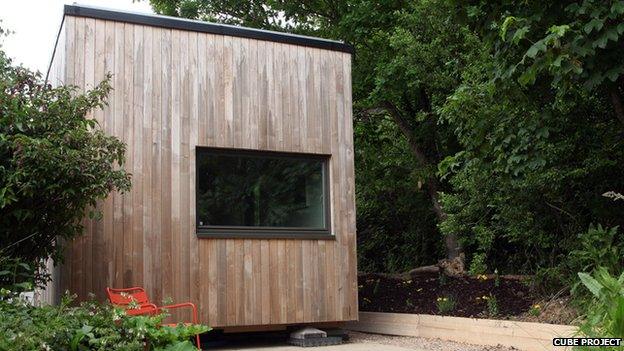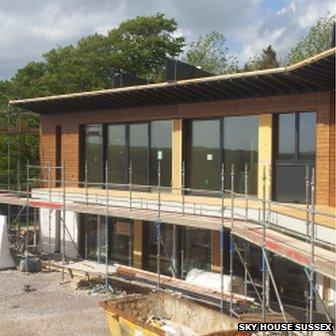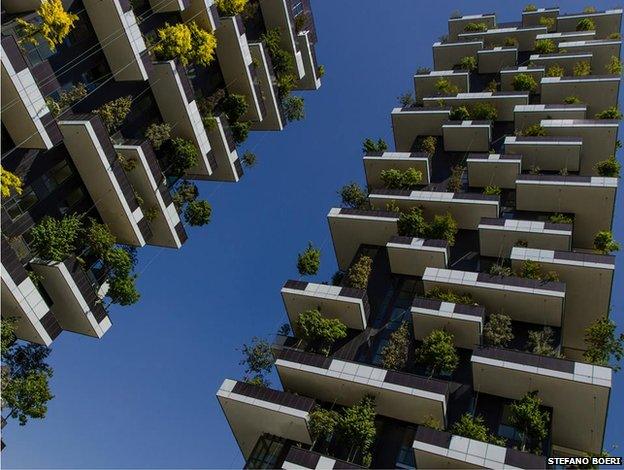Sustainable technology 'greening' our toxic buildings
- Published
martinehamiltonknight.jpg)
John Christophers' Zero Carbon House in Birmingham makes about £1,200 a quarter selling electricity back to the grid
It is a sobering thought that buildings - those spaces in which we work, rest, and seek shelter - could also be threatening our very survival.
Residential and commercial buildings contribute about 25% of global CO2 emissions each year, says the International Panel on Climate Change, external.
Lighting, heating, and cooling form an unholy trio of activities contributing massively to global warming, with all the extreme weather events and natural resource scarcity this is precipitating.
Our buildings have become toxic for the planet.
Radical retrofit
The problem is that most of them are old, draughty and thermally inefficient. And about 60% of buildings around today will still be here in 2050, locking in that inefficiency for decades to come.
As knocking them all down and starting from scratch isn't an efficient option, retrofitting - adding energy-saving features and management technologies to existing buildings - is the only course.
For example, John Christophers, of Associated Architects, transformed his 170-year-old two-bedroom terraced house in Birmingham into a four-bedroom exemplar of zero carbon living.
"We wanted to use the power of architecture and design to reach people who wouldn't usually have any interest in the green agenda," he told the BBC.
Green generation
By creating an airtight skin around the house, incorporating solar photovoltaic panels, and massively improving the thermal efficiency using triple glazing and the latest insulation materials, Mr Christophers turned a "leaky old house" into one making "about £1,200 a quarter from selling our electricity back to the grid."
A mechanical ventilation heat recovery (MVHR) system transfers heat from the internal air flowing out to the cooler air coming in.
"About 93% of the internal heat is recovered this way," says Mr Christophers.
Hydraulically compressed clay blocks were used as they absorb and radiate heat better than traditional cement blocks, and rammed earth floors on top of 250mm insulation helped with heat retention.
martinehamiltonknight.jpg)
John Christophers turned a "leaky" two-bed house into a modern, thermally efficient four-bed zero carbon home
While Mr Christophers would not reveal the total cost of the project, he did say it would pay for itself within eight years.
Domestic strife
While such projects show what can be done, the inefficiency of the existing brick-built housing stock remains a major problem.
"Reducing the energy consumption of the average house is probably the biggest challenge," says Dr Craig Jones, of carbon footprinting specialist Circular Ecology.
"Solid walls need extra layers of insulation on the outside and inside and this has implications for the positioning of the windows, not to mention what owners, neighbours and planners will think," he says.
A big study - Retrofit for the Future, external - funded by the Technology Strategy Board and conducted by the Energy Saving Trust and big data analyst Mastodon C - measured the energy input and output of 120 homes fitted with a range of energy-saving technologies.
The £17m project concluded that households could reduce their energy consumption by up to 80% by making the properties air tight and insulating the walls, roofs, floors, windows and doors, as well as installing more efficient heating and lighting systems and adding MVHR systems.
But adding all these to a standard two-up-two-down brick terraced house can be fiddly and expensive, the report found, while properly integrating the different technologies can also pose problems.
Then there's the money issue.
Incentive schemes, such as the UK government's Green Deal, do encourage homeowners and landlords to insulate and draught-proof their buildings. But take-up has been slow.
"Getting people and the building industry to change their behaviour is very difficult - it needs policymakers and legislators to step in and take a lead," says Mr Jones.
Low carbon living
By contrast, building a zero carbon home from scratch is almost child's play, says Dr Mike Page, the brains behind the Cube Project, a compact low-carbon home.
"I set up this project as a way of demonstrating that, with the correct low carbon technologies and techniques, it was possible to live a net zero carbon life in the UK using existing materials and without necessitating a sacrificial drop in living standards," he told the BBC.

Compact zero carbon living is possible using existing technologies, says Cube Project's Dr Mike Page
.jpg)
The QB2 house packs a lot of functionality in to a small space
The latest version of the house, QB2, features a wood frame, triple glazing, 140mm thick PIR (polyisocyanurate) board insulation, heat recovery ventilation and an air source heat pump.
"These technologies are not exotic," he points out. "They've been around for a while."
Simple changes, like switching to a low-flow shower head that aerates the water so less of it is needed, can cut the amount of energy needed to heat the water by about a third, Mr Page maintains.
The only relatively hi-tech kit includes a thermally efficient induction hob for cooking, LED lighting and an LED TV.
"The point about this building is that it doesn't have to be small - everything scales up," he says.
Praise for prefab

Amy Burgess's East Sussex zero carbon home was constructed in five days
US entrepreneur and eco-evangelist Amy Burgess saw her zero carbon Sky House go up in just five days, external.
The timber frame and insulated structural wall panels were prefabricated off-site by German eco-home specialist Baufritz and delivered ready-made to the site in Lewes, East Sussex.
Reducing construction time in this way helps lower the carbon emissions produced by a new build project.
"Building a zero carbon home is my response to today's challenges of climate change and the need for clean energy," she said.
Thanks to renewable energy generation from solar photovoltaic panels, Ms Burgess hopes the carbon emissions from running the home - as well as the carbon used in the making of its materials - will be offset over the 100-year lifespan of the building.
Office politics
Commercial buildings can also benefit greatly from retrofitting, says Bruno Gardner, managing director of Low Carbon Workplace, a joint venture between Carbon Trust, Threadneedle and Stanhope.
While some energy-saving technologies, such as LED lighting, are easy to implement and cost-effective, other systems, such as thermal imaging to measure building occupancy, are more complicated, says Mr Gardner.
But very useful nonetheless.
"How a company believes it uses a building is often not reflected in reality," he says. "Once you know the truth you can see that air conditioning doesn't need to come on so early or that the heating doesn't need to come on so much."

Boeri Studio's Bosco Verticale tower blocks in Milan offer a new vision of green, low energy urban living
Appliance control systems, cladding, natural cooling systems and other technologies can reduce carbon emissions by 33%, he says.
The next step will be integrating occupancy sensors into the control systems, Mr Gardner adds, so that ventilation adapts throughout the day to how many people are in the building.
So we clearly have the technologies available to green our toxic buildings.
The question is: Do we have the political will and the right commercial incentives to make it happen?